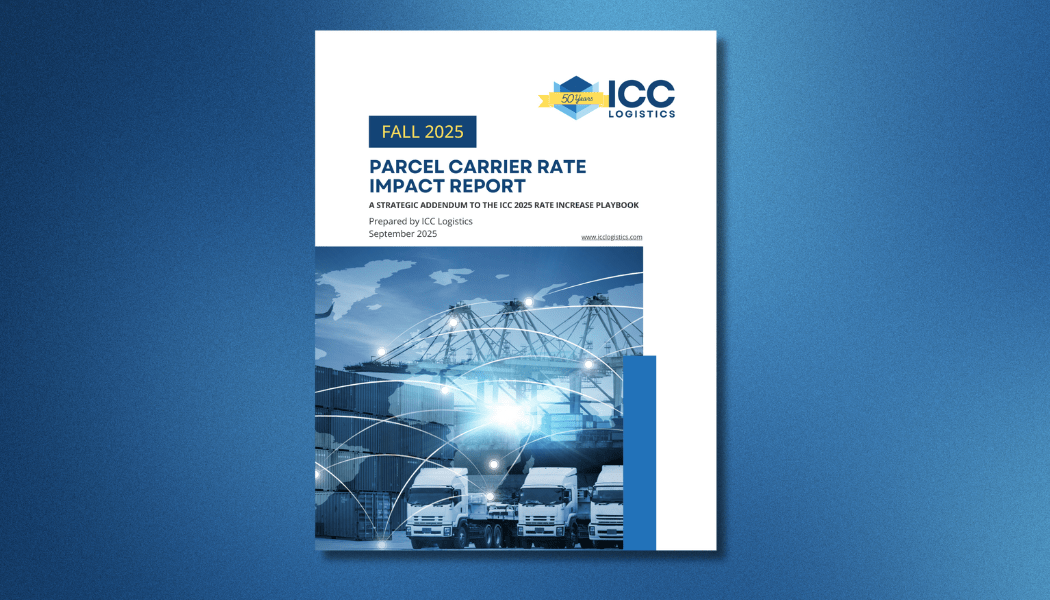The Hidden Weight of Surcharges
Rising parcel rates get plenty of attention — but it’s the hidden surcharges that quietly drain budgets. Dimensional Weight (DIM) rounding, Delivery Area Surcharges (DAS), and a long list of accessorial fees often slip through unnoticed, inflating invoices month after month. For high-volume shippers, those “nickel-and-dime” charges can add up to millions every year.
Too often, companies treat them as a cost of doing business, but they don’t have to be. With the right shipping surcharge analysis, organizations can pinpoint where the leakage is happening, recover dollars that never should have been spent, and build real financial predictability into their transportation budgets.
At ICC Logistics, we’ve seen it firsthand. For over 50 years, we’ve helped businesses go beyond the surface of carrier contracts — using audits, detailed contract reviews, and recurring surcharge recovery strategies to turn hidden fees into measurable savings.
What Are the Most Common Parcel Shipping Surcharges?
Carriers like UPS and FedEx impose hundreds of fees beyond base shipping rates. Some of the most costly and impactful include:
- Additional Handling Fees – Triggered by packages that exceed certain size, weight, or packaging thresholds.
- Dimensional (DIM) Weight Adjustments – Billing based on package volume rather than actual weight, often with aggressive rounding rules.
- Delivery Area Surcharges (DAS) – Applied to deliveries in residential, rural, or extended ZIP code areas.
- Residential Surcharges – Extra fees whenever the final destination is classified as non-commercial.
- Peak/High-Volume Fees – Seasonal charges, especially around holidays, that catch many shippers off guard and compound costs dramatically.
Individually, these fees may appear minor, but across thousands of parcels, they can drain profitability and silently erode supply chain competitiveness.
Why Are My Shipping Charges Higher Than Expected?
Many companies assume their quoted “per box” rate equals their true shipping cost, only to be shocked when they review detailed invoices. Frequent culprits include DAS and Additional Handling charges, which often amplify costs far beyond base rates.
For example:
- A lightweight product shipped in an oversized box can be billed at nearly triple the expected rate under DIM rules.
- A package routed through a rural ZIP code immediately triggers a DAS surcharge, even if that address is only marginally outside urban areas.
This unpredictability makes it difficult for supply chain managers and CFOs to build accurate budgets. In fact, industry reports have shown that surcharges can represent 20–30% of total parcel costs if unmanaged.
How Shipping Surcharge Analysis Saves Money
Strategic shipping surcharge analysis does more than expose surprise fees—it quantifies their total financial footprint and prescribes actionable solutions. Effective analysis provides:
- Identification of Overcharges and Errors – Frequent carrier billing mistakes can be reclaimed if caught promptly through auditing.
- Packaging Optimization – Small engineering adjustments to box size or packing material choices dramatically lower DIM exposure and Additional Handling fees.
- Residential and DAS Management – Geo-mapping destination profiles can guide rerouting or carrier diversification to reduce costs.
- Forecasting and Transparency – With clear knowledge of surcharge trends, finance teams gain the ability to budget more precisely.
Our Parcel Carrier Audit Services routinely uncover recurring mistakes and surcharge leaks missed internally. Importantly, these findings don’t just result in one-off savings; they drive recoverable, repeatable cost reductions year-round.
How Can I Reduce Costs from Additional Handling or DAS Fees?
Parcel shippers may feel these surcharges are outside their control, but multiple proven strategies exist to minimize or even eliminate them. ICC Logistics recommends:
- Audit Regularly – Use a structured Parcel Audit Checklist to proactively monitor weight breakpoints, package dimensions, and carrier triggers.
- Negotiate with Carriers – Even if base rate discounts are locked, concessions on surcharges are frequently achievable for large accounts.
- Align Services Correctly – Matching the right carrier service level (such as hybrid alternatives) with your delivery profile reduces residential and DAS exposure.
- Redesign Cartonization Strategies – Optimizing how products are packaged — sometimes shaving an inch or two off — may mean significant recurring savings against DIM charges.
In practice, it’s not uncommon for businesses to lower shipping expenses by double-digit percentages through packaging redesigns and renegotiated surcharge terms, without switching carriers.
Breaking Down Key Surcharges
- Additional Handling – Imposed when packages exceed limits for weight, shape, or packaging. These thresholds change regularly, so ongoing monitoring is essential.
- DIM Weight Rounding – Carriers round dimensions upward—e.g., a 12.3” box is billed as 13”. This seemingly small detail pushes packages into higher price brackets.
- Delivery Area Surcharges (DAS) – ZIP code–based, disproportionately impacting rural and residential areas. For some shippers, DAS costs can comprise over 10% of invoices.
- Residential Surcharges – Even cost-saving “Ground Saver” products still include non-commercial address fees. Better address validation minimizes these errors.
- High-Volume Multipliers – During peak holiday or promotional surges, carriers layer on multipliers that inflate per-shipment costs and trigger volume-based thresholds.
The Graveyard of Recurring Fees
Think of your parcel statement as a graveyard of recurring fees: DIM rounding, DAS, Residential, and Additional Handling, all eroding ROI without enhancing customer experience. With invoices often running dozens of pages, finance teams rarely scrutinize each line item. Yet when they finally do, the insight is staggering. The missing profits could otherwise fuel strategic investments, competitive pricing, or supply chain resiliency.
Why a Parcel Surcharge Audit is Essential
A parcel surcharge audit must be seen not as a one-time cost-cutting initiative but as a continuous operational discipline. Left unchecked, surcharges accumulate yearly like compound interest. In contrast, consistent auditing empowers businesses to:
- Validate contract compliance.
- Pinpoint recurring surcharge categories driving major cost leaks.
- Negotiate from a position of strength backed with real data.
- Clarify true landed costs for smarter pricing and profitability decisions.
Ultimately, auditing transforms shipping expense management into a strategic advantage.
FAQ‘s
What are the most common parcel shipping surcharges?
The most frequent include Additional Handling, DIM Weight, DAS, Residential Surcharges, and peak-related add-ons.
How can I reduce costs from Additional Handling or DAS fees?
By redesigning packaging, aligning services to delivery profiles, negotiating with carriers, and instituting proactive audits.
What is a parcel surcharge audit?
A deeply detailed review of carrier invoices to uncover hidden or misapplied fees, recover overcharges, and establish long-term cost control mechanisms.
Why are my shipping charges higher than expected?
Because non-transparent surcharges accumulate on top of base rates—especially when shipping to residential and rural areas, or when DIM weight rules apply.
Turning Analysis into Action
For supply chain leaders, ignoring recurring parcel fees is no longer viable. Surcharges are rising every contract year, supply chain margins are pressured, and carriers continually revise fee structures. By investing in shipping surcharge analysis and independent parcel auditing, organizations unlock not only direct refunds but also operational resilience and budgeting clarity.
At ICC Logistics, our decades of parcel auditing expertise equip clients to handle carrier complexity with confidence.
Through Parcel Carrier Audit Services and strategic consulting engagements, we consistently drive double-digit cost reductions for shippers across industries.
For more strategies and insights, explore related resources on our site:
- Parcel Auditing vs Freight Auditing: What’s the Difference?
- Understanding Surcharge Recovery and Hidden Fees in Shipping
- Stay Ahead of the Latest UPS & FedEx Rate Hikes
- Benchmarking For Logistics Contracts: How Data Creates Carrier Negotiation Leverage
- What Hidden Clauses Should You Look For In a Shipping Contract?
Subscribe to Logistics Strategies
No noise. Just insights.
Get direct access to every post, resource, and real-world breakdown. From parcel trends to freight cost strategies — all backed by 50 years of logistics expertise.
Every post lands in your inbox, ad-free and to the point. Prefer to listen? Use the Substack app for a clean, distraction-free experience with audio and community features.
Join a community that gets it.
We’re building a space for supply chain pros, ops leaders, and curious minds who want to stay sharp – without the fluff. Your voice is welcome here.
To learn more about the tech platform that powers this publication, visit Substack.com.



 to receive our FREE white papers:
to receive our FREE white papers: